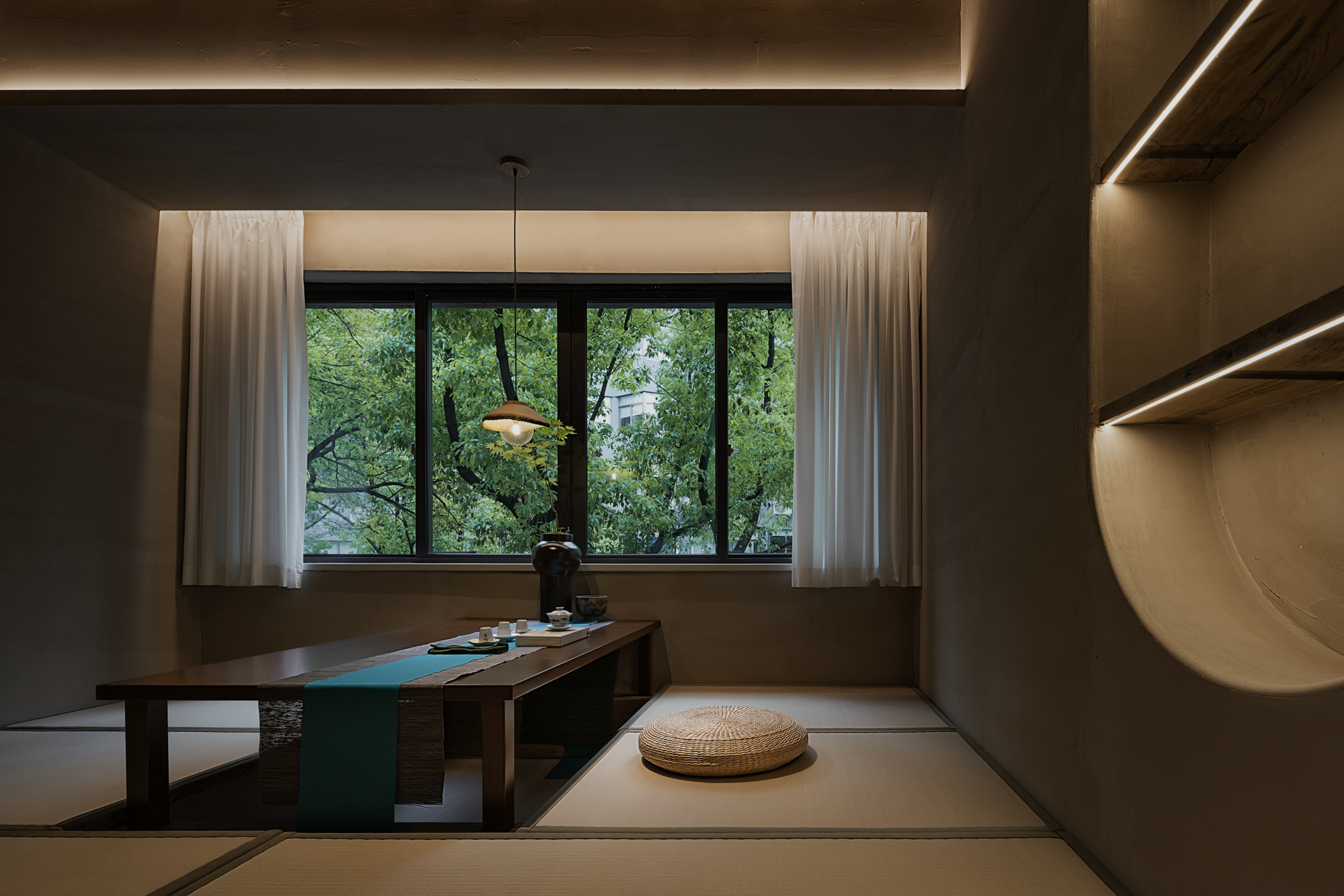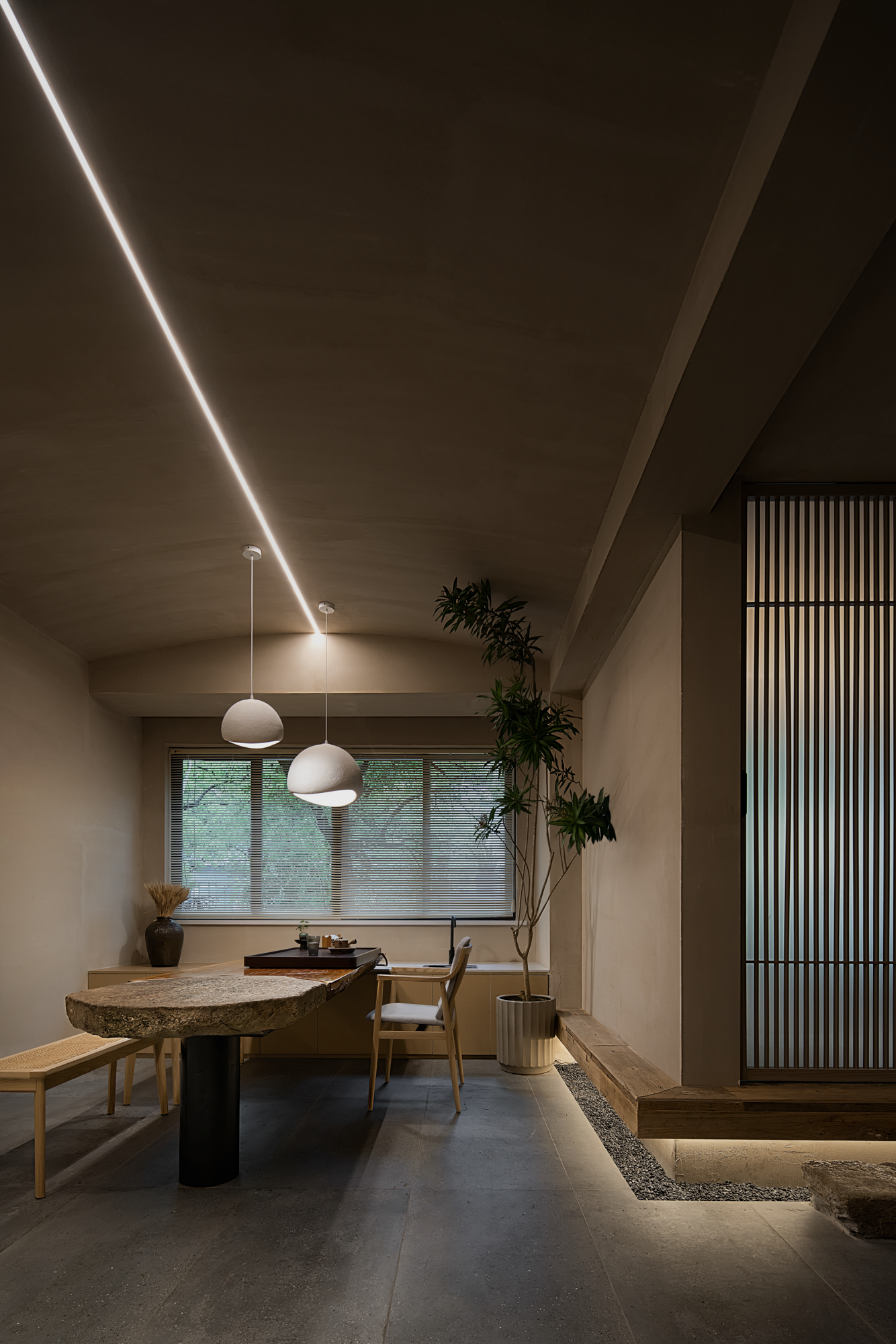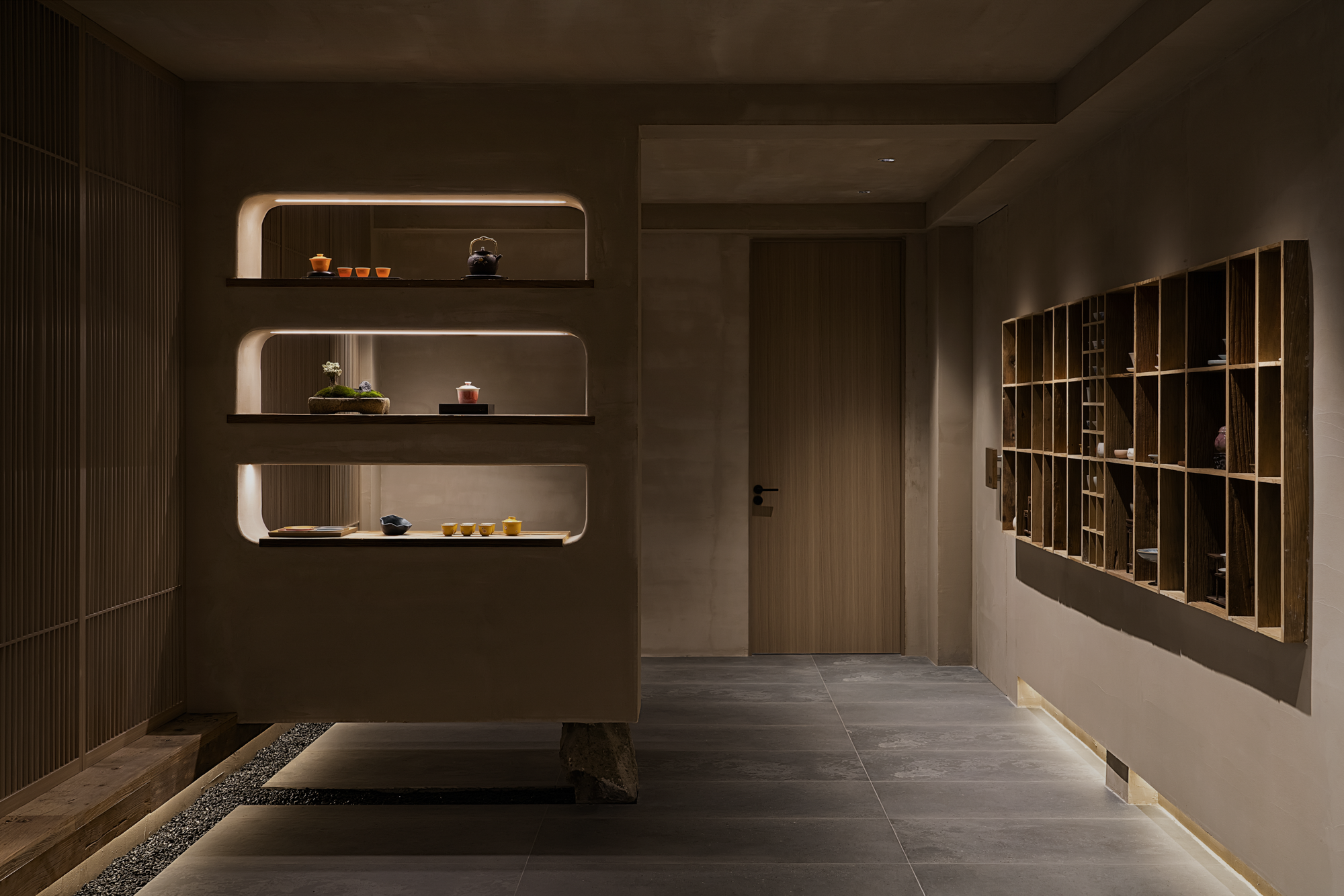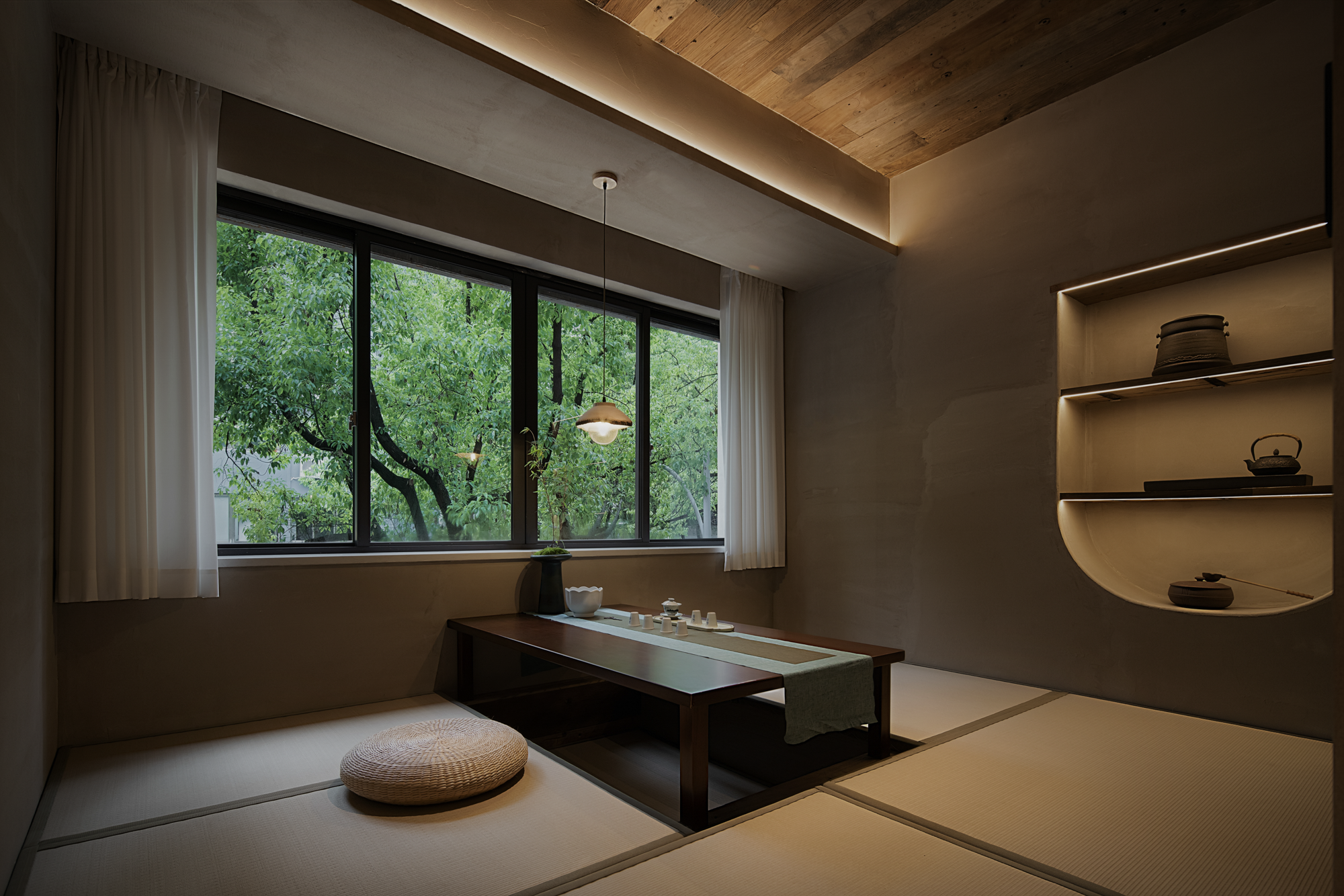Syria teahouse 叙 茶馆
茶事旧约,叙谈新话
人会老去,事物会老去,空间也是。
老空间承载着几代人的记忆,在经年的使用后,空间的功能性或许早已不能与飞速发展的时代相匹配,但其所蕴含的“时间价值”却早已超出空间本身的表达。
“丹霞茶馆”自戊寅年起,因茶茗飘香而闻名乐清,但随着城市发展的脚步日益稳健,原址为建藏书馆所用,不得不另觅新处。
但茶与书,皆是久经岁月而历久弥香,也算是一场跨时空的邂逅了。
“叙茶馆”,意为“叙旧饮茶”。
子承父业不仅仅是为了营生,更是在这飞速发展的城市里,为好茶的老客留一处可供回忆消遣的去处。叙茶馆,亦非传统意义上的茶馆,而是将更多的力量集中于对现在与过去的连接中,我们希望这是一个被时光遗忘的角落。
项目位于乐清老城区,原是一间素食的餐馆,喧闹嘈杂的市井气息恰巧适合经营一间茶馆,供过往的邻居们闲坐喝茶。
一楼自楼梯为始展开叙述,未经修饰的水泥纹路带着天然的质朴感,与茶馆主人想要体现的“呼吸感”,“自然感”相弥合。无人的门厅为路过的行人提供休憩的场所,可自在相宜,亦可寻着茶香上楼一探究竟。
拆除所有可被打开的立面,空间得以自由呼吸。通过柔和的线条与镂空的隔断,打造轻巧的贯通感,物与面之间,对立发生,意趣盎然。
同时依据结构与设计所需,重塑动线与功能分区,室外的景观与室内的绿植相互映射,被纳入空间的设计中去,界内与界外形成对话。
空间的商业属性决定了展陈区域的必要存在,设置于二楼入口处,作为空间的第二印象呈现于外,同时亦是为空间主题“茶”进行阐述与点名。
空间自茶而始,半弧形线条围绕着展陈区域徐徐展开,柔化了的线条结合暖色灯光的铺陈,赋予空间柔和恬淡的叙事感。
本案的原身“丹霞茶馆”,亦是此案设计师早年的作品,空间的旧址焕新,无论对于委托方亦或是设计师,都是同样的心情,是在不舍与逐新中不断拉锯的过程。
关于老茶馆的记忆投射,通过从旧址搬来的老家具得以体现,经过重新设计改造,使之适配新空间的结构形态。
“开”意为空间平面的展开,通达豁然为主旋律。
“合”则引述较为私密的空间场域,强调静与守。
作为商业空间本身,图求多人次的同时在座,但“茶”文化又追求相对安静独立的空间感受,其本身之间的矛盾恰因空间的开与合迎刃而解,在解决问题的同时,建立起富有层次的秩序感。
从废弃的旧址得来的老木与顽石,在新空间中迎来新生,岁月的痕迹没有使之黯然失色,反而磨平了棱角,触手温润。空间不断地复述着新与旧的对话,讲究细节处的平衡,灯光的露于藏都被处理的恰到好处。
空间的动态感讲究内与外的相合,室外的枝叶繁茂恰巧被框入室内,与内景相互掩映,如同落座于林中。在这繁华喧闹的市中心,能辟得一处如归山野的所在,亦可谓一桩幸事。
Tea Testament, new talk
People will grow old, things will grow old, and so is the space.
Old space carries the memory of several generations. After years of use, the function of the space may no longer be able to match the era of rapid development, but the "time value" contained in it has long gone beyond the expression of the space itself.
Since the year of Wuyin, "Danxia Teahouse" has been famous for the fragrance of tea. However, with the increasingly steady development of the city, the original site was used for the construction of the library, so we had to find a new place.
But tea and books, are long years and more fragrant, is also an encounter across time and space.
"Syrian teahouse" means "old tea".
Inheriting his father's business is not only for making a living, but also for leaving a place for the old guests of good tea in this rapidly developing city. The Syrian teahouse is not a teahouse in the traditional sense, but focuses more power on the connection between the present and the past. We hope that this is a corner forgotten by time.
The project is located in the old city of Yueqing. It was originally a vegetarian restaurant. The noisy and noisy market atmosphere happened to be suitable for running a teahouse for the passing neighbors to sit down and drink tea.
The stairs of the first floor are narrated from the beginning of the narrative, the unmodified cement grain with a natural sense of simplicity, and the "breathing sense" and "natural sense" that the teahouse owners want to reflect together. Unmanned entrance hall for the passers-by to provide a rest place, can be comfortable and appropriate, can also find out the fragrance of tea to go upstairs to find out.
Remove all the facades that can be opened, and the space can breathe freely. Through the soft line and hollow out partition, to create a light through the sense, between things and the surface, the opposition occurs, full of interest.
At the same time, according to the needs of structure and design, the dynamic line and functional partition are reshaped, outdoor landscape and indoor green plants are apped to each other, and are incorporated into the design of space, forming a dialogue between the boundary and outside the boundary.
The commercial attribute of the space determines the necessary existence of the exhibition area. It is set at the entrance of the second floor, and is presented as the second impression of the space, and it is also elaborated and named for the space theme of "tea".
The space begins with tea, and the semi-arc lines are slowly spread out around the exhibition area. The soft lines combined with the spread out of warm color lights give the space a soft and tranquil narrative sense.
The original body of this case, "Danxia Teahouse", is also the work of the designer in the early years of the case. The old site of the space is refreshed. No matter for the client or the designer, it is the same mood, which is the process of constantly seesaw in not giving up and chasing the new.
The memory projection of the old teahouse is reflected by the old furniture moved from the old site, and is redesigned and then redesigned to adapt it to the structural form of the new space.
"Open" means the expansion of the space plane, and access suddenly is the main melody.
"Close" quotes the more private space field, emphasizing static and keep.
As a commercial space itself, it is present for many people at the same time, but the "tea" culture also pursues a relatively quiet and independent space feeling. The contradictions between it are only solved precisely due to the opening and combination of the space. While solving the problems, it establishes a hierarchical sense of order.
The old wood and stone derived from the abandoned old site ushered in a new life in the new space. The traces of time did not eclipse it, but smoothed the edges and corners, warm and warm. The space is constantly retelling the dialogue between the new and the old, pay attention to the balance of the details, the light exposed in the hidden is handled just right.
The dynamic sense of the space pays attention to the combination of the inside and the outside. The luxuriant outdoor branches and leaves happen to be framed into the room, and they are hidden with the interior of each other, just like sitting in the forest. In this bustling city center, it is also a blessing to find a place in the mountains.











